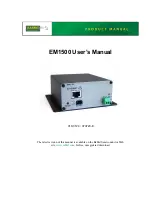
Wiring the Inverter/Charger
975-0209-01-01
2–5
AC Wiring
Overview
The U.S. National Electrical Code (NEC) defines the standards for AC and DC
installation wiring in RV applications, but there are still many installation
variables. Most are determined by the level of automatic switching desired and the
amount of external AC power to be switched.
Installation should be done by a qualified electrician. Consult local code for the
proper wire sizes, connectors and conduit.
The AC and DC terminals are located on the same end of the chassis as the status
LED and power switch. A six station terminal block is provided to connect the AC
input and AC output. All terminals are labeled on the inverter. Consult your local
code for proper wire sizes, connectors, conduit, and so on. See Table 2-1 for
minimum recommended wire sizing. Code requires that an external disconnect
switch be used in the AC input wiring circuit. The AC breakers in a sub panel will
meet this requirement.
Figure 2-1
RV Electrical System Diagram
Important:
Figure 2-1 does not show all required grounding or over-current protection.
Generator
Isolator
Non-Inverter Loads
Engine Battery
GFCI
Transfer Switch
AC Main Panel
AC In
AC Out
UtilityPower
Inverter AC Panel
Alternator
TEST MONTHLY
RESET
RESET
TEST
TEST
RC/GS Remote
/
RV Series Inverter/Charger
PN
27
0-0
69
7-0
1-0
1
30
60A
30A
DC +
DC -
DC Fuse
House Battery
Battery Temperature
Sensor
Engine Negative Terminal
Sensing and control
DC Load Center
Grounding (Bonding) Bus
DC Negative Grounding Bus
DC Positive Bus
+
Summary of Contents for RV2012GS
Page 2: ......
Page 5: ...RV Series Inverter Charger Owner s Manual ...
Page 10: ...viii ...
Page 18: ...1 6 ...
Page 52: ...3 12 ...
Page 58: ...A 4 ...
Page 63: ......
















































